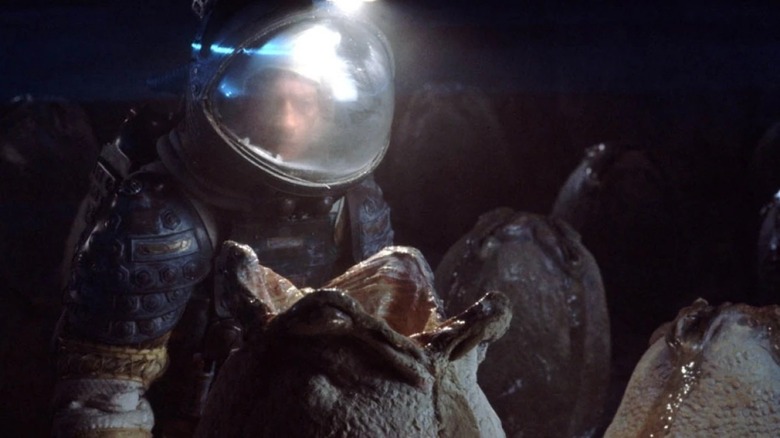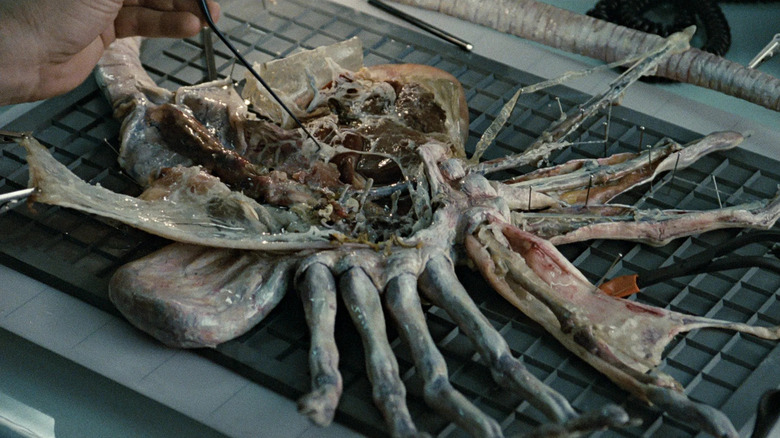First Designs For Alien's Eggs Evoked Worry From The Horror Movie's Producers
It's easy to take for granted the strangeness of the creatures from Ridley Scott's 1979 sci-fi horror film "Alien." Because that film was such a hit, and because it has spawned many sequels, comics, video games, and Halloween costumes in the last 45 years, the Xenomorphs no longer seem weird or even all that creepy. One must cast one's mind back to 1979 to recall that, yes, the aliens were horrifyingly off-putting, bizarre, and terrifying; the title is both a noun and an adjective. By the time the PG-13-rated "Alien vs. Predator" came out in 2004, audiences knew that Xenomorphs forcibly incubated their young inside people's bodies. In 1979, that notion was novel.
To remind audiences: a Xenomorph begins its life inside a three-foot leathery egg. When the egg hatches, a spider-crab monster leaps out and attaches itself to a victim's mouth. Over the course of a few days, it inserts an ovipositor down its victim's throat and implants a Xenomorph fetus. It then falls off its victim's face and dies. Another day passes with the victim feeling fine. Then, quite suddenly, a baby Xenomorph will burst out of the chest of its host. It grows to human size within a matter of hours. In the director's cut of "Alien," it's explained that new eggs are constructed out of cocooned human victims. In James Cameron's "Aliens," a "queen" alien lays the eggs.
In 2019, Roger Christian, the production designer for "Alien," spoke with EW about the initial blueprints for the leathery face-hugger eggs. The creatures for "Alien" were designed by Swiss surrealist H.R. Giger, and he drew the eggs to have a cross-shaped aperture at the top. Christian noted that the cross was a reaction to Giger's first rejected idea, as he wanted the egg apertures to be undeniably vaginal.
Genital imagery
It's worth remembering that "Alien" is rife with genital imagery, mostly taken from H.R. Giger's works. Giger's paintings tended to blend the mechanical and the organic, often envisioning a post-apocalyptic hell wherein human-like figures were still beholden to sexual impulses, but whose bodies had been partially absorbed into ineffable, tube-sprouting contraptions. Indeed, the design for the Xenomorph itself comes from a painting called "Necronom IV," wherein a human-shaped figure sported a skull that was extending backward into a massive phallus. The creature's own phallus was large enough to extend upward over its own head. The movie Xenomorph was, not to put too fine a point on it, a penis monster.
It would aesthetically follow, then, that the alien eggs should also feature genital features. Giger designed a vulval opening in the top of the egg, further expressing his own genital-heavy interests. When that idea was rejected, Giger pivoted to the "cross shape" as an impish piece of satire; if the filmmakers were going to be puritanical about genital imagery, then he'd provide a Christian design to placate the prudes. Roger Christian said it thus:
"The first ones he did looked much more like a woman's private parts, and the producers all worried. [...] Giger said, 'Well, if it's a cross, then it's religious, and people don't worry about that.'"
The final design of the egg isn't so much Christian as it is cardiovascular; the four-flapped egg opening looks like an outsize heart valve. It may have been Giger's sneaky Christian "prank," however, that would inform director Ridley Scott when he made his prequel film "Prometheus" in 2012.
From the birth canal to the cross
Giger passed away in 2014, but stopped contributing to films after designing the creatures for the 1996 German horror/comedy "Killer Condom." As such, he wasn't actively involved in "Prometheus," despite the film relying heavily on his 1979 designs. One might note that "Prometheus" is far less "organic" than "Alien" in its designs, with Scott choosing more liturgical images for his extraterrestrial worlds. The aliens in "Prometheus" don't live in goopy eggs, but emerge from geometric amphorae. Scott must have latched onto the image of a face-hugger leaping out of a cross-shaped opening and expanded upon it.
Indeed, if one works out the timing in the "Prometheus" plot, one will find it to be an Old Testament-style parable. It seems that tall, statuesque aliens — Engineers — visited pre-historic Earth to seed it with their DNA; the opening scene is an Engineer dissolving its own body in order to fulfill this goal, tapping into religious notions of self-sacrifice to bring new life into the world. Then, about 2200 years ago, the Engineers returned to talk to Earth's humans, offering them messages of peace as well as a map back to their home planet.
It seems that the humans on Earth executed the Engineer ambassador, which angered the faraway alien home planet. It took two millennia, but the Engineers constructed a menagerie of murderous alien creatures with the intent of killing all of humanity. 22nd-century astronauts discover all this information on their first visit to the Engineer planet ... on Christmas day.
Yeah, it seems that Jesus Christ was an Engineer, and Xenomorphs were created by the Engineers to wipe out humanity as revenge for Christ's crucifixion.
Perhaps all because the producers of "Alien" didn't like Giger's vaginal egg designs.


